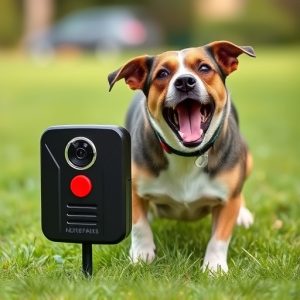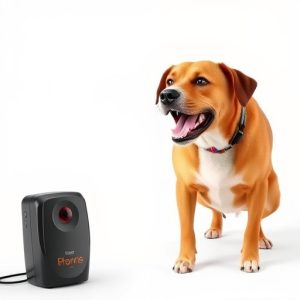Handheld Sonic Dog Deterrents: Evaluating Effectiveness for Animal Control
Handheld sonic dog deterrents, using high-frequency sound waves imperceptible to humans, are a popul…….
Handheld sonic dog deterrents, using high-frequency sound waves imperceptible to humans, are a popular and humane method for managing urban canine behavior. Their effectiveness lies in startling dogs without harm, facilitating training and addressing aggression. For optimal results, these devices should be activated precisely when dogs display unwanted behaviors, paired with rewards or praise for positive alternatives. While mixed results exist due to variability in noise levels, frequency, animal behavior, and individual dog sensitivity, handheld sonic deterrents have shown promise in controlled settings and are gaining traction as innovative solutions for human-wildlife conflict.
“Discover the innovative world of animal control with handheld sonic dog deterrents, a growing solution for managing canine behavior. This article explores the science behind these devices, delving into how sonic technology effectively repels dogs without harm. We weigh the success rates of handheld devices and provide insights on their practical use. Additionally, we discuss future prospects and considerations, offering a comprehensive guide to understanding the potential and limitations of this unique animal control tool, with a focus on its effectiveness.”
- Understanding Handheld Sonic Dog Deterrents
- How Does Sonic Technology Work in Animal Control?
- Evaluating the Effectiveness of Handheld Devices
- Considerations and Future Prospects for Sonic Animal Control Tools
Understanding Handheld Sonic Dog Deterrents
Handheld sonic dog deterrents have gained popularity as a non-lethal way to control canine behavior, particularly in urban areas where traditional methods may be less desirable. These devices emit high-frequency sound waves that are invisible to the human ear but can be extremely disturbing to dogs. The effectiveness of these deterrents lies in their ability to startle and disrupt dogs without causing them harm, making them a humane alternative for training or addressing aggressive behaviors.
When used correctly, handheld sonic dog deterrents can train dogs to associate certain areas or behaviors with an unpleasant sound, encouraging them to avoid those places or modify their actions. However, like any behavior modification tool, consistency and timing are crucial. The key to success is to activate the device at the precise moment the dog exhibits unwanted behavior, reinforcing positive alternatives through rewards or praise.
How Does Sonic Technology Work in Animal Control?
Sonic technology in animal control utilizes high-frequency sound waves to create an effective deterrent for dogs and other animals. This innovative approach differs from traditional methods by employing a non-lethal, humane strategy that disrupts an animal’s ability to hear and communicate. Handheld sonic dog deterrents emit sounds beyond the human hearing range but are sensed by canines through their sensitive eardrums.
The handheld devices are designed to capture and amplify specific frequencies that provoke an instinctive response in dogs, often causing them to flee or avoid the area. The effectiveness of this method lies in its ability to target animals without causing harm, making it a popular choice for both residential and commercial settings. By using sound as a tool, animal control measures can be more precise and environmentally friendly while addressing issues related to dog behavior and trespassing.
Evaluating the Effectiveness of Handheld Devices
Evaluating the effectiveness of handheld devices, such as sonic dog deterrents, is crucial in understanding their real-world applications. These compact tools emit high-frequency sound waves designed to disrupt and discomfort animals, particularly dogs, without causing harm. Research suggests that their success varies greatly depending on factors like noise level, frequency range, and the training and behavior of the target animal.
In controlled settings, handheld sonic deterrents have shown promise in repelling dogs from specific areas. However, their effectiveness outdoors can be challenged by ambient noise, distance, and the ability to consistently target the animal. Moreover, while they may work for some dogs, others might prove more resilient or less sensitive to the sound waves, rendering them less reliable as a universal solution for pet owners and agricultural settings.
Considerations and Future Prospects for Sonic Animal Control Tools
Sonic animal control tools, specifically designed for non-lethal deterrence, have gained attention as an innovative approach to managing human-wildlife conflict. These handheld devices emit high-frequency sound waves that target specific animals’ hearing, creating a disruptive experience without causing harm. The effectiveness of handheld sonic dog deterrents, for instance, has been demonstrated in various studies, showing reduced aggressive behavior and increased aversion in targeted canine species.
Looking ahead, the future of sonic animal control technology promises refined designs, improved targeting capabilities, and enhanced user-friendliness. Ongoing research aims to develop tools that are species-specific, reducing off-target effects, and incorporating adaptive learning algorithms to adjust sound patterns based on animal behavior responses. As these devices continue to evolve, they offer a promising alternative for human-animal coexistence, particularly in urban areas where traditional methods may be limited or undesirable.
Handheld sonic dog deterrents have emerged as an innovative tool in animal control, offering a non-lethal and humane method to address unwanted canine behavior. The effectiveness of these devices lies in their ability to emit high-frequency sound waves that disrupt animals’ communication and sense of comfort without causing harm. While studies show promising results, further research is needed to optimize the technology and understand its long-term impact on animal welfare and behavior. As we continue to explore sonic animal control tools, evaluating their performance and addressing potential concerns will be crucial for developing effective and ethical solutions.


